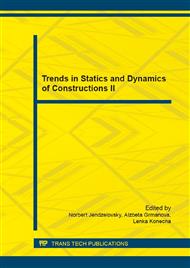p.146
p.152
p.157
p.163
p.167
p.175
p.179
p.183
p.187
From Fracture Experiments to Advanced Design and Assessment of Precast Structural Members
Abstract:
An objective reliability analysis of structural members made of advanced cementitious composites must be based on good knowledge of stochastic properties of individual mechanical fracture parameters of utilized material models. The article presents a comprehensive approach to the design and assessment of precast structural elements including: The series of fracture tests of the two concrete mixtures with various ages in two configurations (three point bending and wedge splitting test, subsequent identification of material parameters using effective crack model, work of fracture method and artificial neural networks, execution of destructive tests of scaled structural members and creation of deterministic models of these tests using collected data. In subsequent phases of the project reliability analysis of tested beams will be carried out in order to obtain stochastic parameters of structural response of prestressed elements to shear load. The obtained data will be used to calibrate the analytical equation describing the response of element exposed to both normal and shear forces. The entire process will be concluded by reliability-based optimization of manufactured components.
Info:
Periodical:
Pages:
167-174
Citation:
Online since:
June 2016
Authors:
Price:
Сopyright:
© 2016 Trans Tech Publications Ltd. All Rights Reserved
Share:
Citation:


